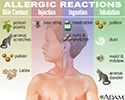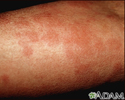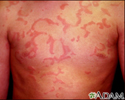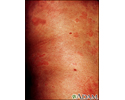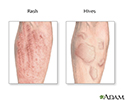Allergic reactions
Allergic reactions are sensitivities to substances called allergens that come into contact with the skin, nose, eyes, respiratory tract, and gastrointestinal tract. They can be breathed into the lungs, swallowed, or injected.
Allergens
An allergen is a substance that can cause an allergic reaction. In some people, the immune system recognizes allergens as foreign or dangerous. As ...

Considerations
Allergic reactions are common. The immune response that causes an allergic reaction is similar to the response that causes hay fever. Most reactions happen soon after contact with an allergen.
Many allergic reactions are mild, while others can be severe and life threatening. They can be confined to a small area of the body, or they may affect the entire body. The most severe form is called anaphylaxis or anaphylactic shock. Allergic reactions occur more often in people who have a family history of allergies .
Anaphylaxis
Anaphylaxis is a life-threatening type of allergic reaction.

Allergies
An allergy is an immune response or reaction to substances that are usually not harmful.

Substances that don't bother most people (such as venom from bee stings and certain foods, medicines, and pollens) can trigger allergic reactions in certain people.
Bee stings
Insect bites and stings can cause an immediate skin reaction. The bite from fire ants and the sting from bees, wasps, and hornets are most often pai...

First-time exposure may produce only a mild reaction. Repeated exposures may lead to more serious reactions. Once a person has had an exposure or an allergic reaction (is sensitized), even a very limited exposure to a very small amount of allergen can trigger a severe reaction.
Most severe allergic reactions occur within seconds or minutes after exposure to the allergen. Some reactions can occur after several hours, particularly if the allergen causes a reaction after it has been eaten. In very rare cases, reactions develop after 24 hours.
Anaphylaxis is a sudden and severe allergic reaction that occurs within minutes of exposure. Immediate medical attention is needed for this condition. Without treatment, anaphylaxis can get worse very quickly and lead to death within 15 minutes.
Causes
Common allergens include:
- Animal dander
- Bee stings or stings from other insects
- Foods, especially nuts, fish, and shellfish
- Insect bites
- Medicines
- Plants
- Pollens
Symptoms
Common symptoms of a mild allergic reaction include:
-
Hives
(especially over the neck and face)
Hives
Hives are raised, often itchy, red bumps (welts) on the surface of the skin. They are usually an allergic reaction to food or medicine. They can al...
 ImageRead Article Now Book Mark Article
ImageRead Article Now Book Mark Article -
Itching
Itching
Itching is a tingling or irritation of the skin that makes you want to scratch the area. Itching may occur all over the body or only in one location...
 ImageRead Article Now Book Mark Article
ImageRead Article Now Book Mark Article - Nasal congestion
-
Rashes
Rashes
Rashes involve changes in the color, feeling or texture of your skin.
 ImageRead Article Now Book Mark Article
ImageRead Article Now Book Mark Article - Watery, red eyes
Symptoms of a moderate or severe reaction include:
- Abdominal pain
- Abnormal (high-pitched) breathing sounds
- Anxiety
- Chest discomfort or tightness
- Cough
- Diarrhea
- Difficulty breathing, wheezing
- Difficulty swallowing
- Dizziness or lightheadedness
- Flushing or redness of the face
- Nausea or vomiting
-
Palpitations
Palpitations
Palpitations are feelings or sensations that your heart is pounding or racing. They can be felt in your chest, throat, or neck. You may:Have an unpl...
 ImageRead Article Now Book Mark Article
ImageRead Article Now Book Mark Article - Swelling of the face, eyes, or tongue
- Unconsciousness
First Aid
For a mild to moderate reaction:
Calm and reassure the person having the reaction. Anxiety can make symptoms worse.
Try to identify the allergen and have the person avoid further contact with it.
- If the person develops an itchy rash, apply cool compresses and an over-the-counter hydrocortisone cream.
- Watch the person for signs of increasing distress.
- Get medical help. For a mild reaction, a health care provider may recommend over-the-counter medications, such as antihistamines.
For a severe allergic reaction (anaphylaxis):
Check the person's airway, breathing, and circulation (the ABC's of Basic Life Support). A warning sign of dangerous throat swelling is a very hoarse or whispered voice, or coarse sounds when the person is breathing in air. If necessary, begin rescue breathing and CPR .
CPR
CPR stands for cardiopulmonary resuscitation. It is an emergency lifesaving procedure that is done when someone's breathing or heartbeat has stopped...
- Call 911.
- Calm and reassure the person.
- If the allergic reaction is from a bee sting, scrape the stinger off the skin with something firm (such as a fingernail or plastic credit card). Do not use tweezers -- squeezing the stinger will release more venom.
- If the person has emergency allergy medicine on hand, help the person take or inject the medicine. Avoid oral medicine if the person is having difficulty breathing.
-
Take steps to prevent
shock
. Have the person lie flat, raise the person's feet about 12 inches (30 centimeters), and cover them with a coat or blanket. Do not place the person in this position if a head, neck, back, or leg injury is suspected or if it causes discomfort.
Shock
Shock is a life-threatening condition that occurs when the body is not getting enough blood flow. Lack of blood flow means that the cells and organs...
 ImageRead Article Now Book Mark Article
ImageRead Article Now Book Mark Article
Do Not
If a person is having an allergic reaction:
- Do not assume that any allergy shots the person has already received will provide complete protection.
- Do not place a pillow under the person's head if he or she is having trouble breathing. This can block the airways.
- Do not give the person anything by mouth if the person is having trouble breathing.
When to Contact a Medical Professional
Call for medical assistance (911) right away if:
- The person is having a severe allergic reaction. Do not wait to see if the reaction is getting worse.
- The person has a history of severe allergic reactions (check for a medical ID tag).
Prevention
To prevent allergic reactions:
- Avoid triggers such as foods and medicines that have caused an allergic reaction in the past. Ask detailed questions about ingredients when you are eating away from home. Carefully check ingredient labels.
- If you have a child who is allergic to certain foods, introduce 1 new food at a time in small amounts so you can recognize an allergic reaction.
- People who have had serious allergic reactions should wear a medical ID tag and carry emergency medicines (such as a chewable form of Chlor-Trimeton and injectable epinephrine or a bee sting kit) according to your provider's instructions.
- Do not use your injectable epinephrine on anyone else. They may have a condition (such as a heart problem) that could be made worse by this drug.
References
Lieberman P, Nicklas RA, Randolph C, et al. Anaphylaxis -- a practice parameter update 2015. Ann Allergy Asthma Immunol . 2015;115(5):341-384. PMID: 26505932 www.ncbi.nlm.nih.gov/pubmed/26505932 .
Wasserman SI. Approach to the patient with allergic or immunologic disease. In: Goldman L, Schafer AI, eds. Goldman's Cecil Medicine . 25th ed. Philadelphia, PA: Elsevier Saunders; 2016:chap 249.
-
Allergic reactions - illustration
Allergic reaction can be provoked by skin contact with poison plants, chemicals and animal scratches, as well as by insect stings. Ingesting or inhaling substances like pollen, animal dander, molds and mildew, dust, nuts and shellfish, may also cause allergic reaction. Medications such as penicillin and other antibiotics are also to be taken with care, to assure an allergic reflex is not triggered.
Allergic reactions
illustration
-
Dermatographism - close-up - illustration
Dermatographism is a condition where lightly scratching the skin raises wheals or welts. Histamine is released, which causes the small blood vessels (capillaries) to dilate, producing redness and localized swelling.
Dermatographism - close-up
illustration
-
Dermatographism on the arm - illustration
Dermatographism is a condition where lightly scratching the skin raises wheals or welts. Histamine is released at the site, causing the small blood vessels (capillaries) to dilate, producing redness and localized swelling.
Dermatographism on the arm
illustration
-
Hives (urticaria) on the arm - illustration
Hives (urticaria) are raised, red, itchy welts, seen here on the arm. The majority of urticaria develop as a result of allergic reactions. Occasionally, they may be associated with autoimmune diseases, infections (parasitosis), drugs, malignancy, or other causes.
Hives (urticaria) on the arm
illustration
-
Hives (urticaria) on the chest - illustration
Hives (urticaria) are raised, red, itchy welts, seen here on the chest. The majority of urticaria develop as a result of allergic reactions. Occasionally they may be associated with autoimmune diseases, infections (parasitosis), drugs, malignancy, or other causes.
Hives (urticaria) on the chest
illustration
-
Hives (urticaria) - close-up - illustration
Hives (urticaria) are raised, red, itchy welts. The majority of urticaria develop as a result of allergic reactions. Occasionally, they may be associated with autoimmune diseases, infections (parasitosis), drugs, malignancy, or other causes.
Hives (urticaria) - close-up
illustration
-
Hives (urticaria) on the trunk - illustration
This person has raised, red, itchy welts (urticaria) on the chest and abdomen. The majority of urticaria develop as a result of allergic reactions. Occasionally, they may be associated with autoimmune diseases, infections (parasitosis), drugs, malignancy, or other causes.
Hives (urticaria) on the trunk
illustration
-
Dermatographism on the back - illustration
In dermatographism, hives are readily produced if the skin is lightly scratched.
Dermatographism on the back
illustration
-
Dermatographism - arm - illustration
Wheal formation at the site of light scratching of the skin.
Dermatographism - arm
illustration
-
Allergic reactions - illustration
Allergic reaction is a sensitivity to a specific substance, called an allergen, that is contacted through the skin, inhaled into the lungs, swallowed or injected. The body's reaction to an allergen can be mild, such as a localized rash, or life-threatening, such as anaphylactic shock.
Allergic reactions
illustration
-
Allergic reactions - illustration
Allergic reaction can be provoked by skin contact with poison plants, chemicals and animal scratches, as well as by insect stings. Ingesting or inhaling substances like pollen, animal dander, molds and mildew, dust, nuts and shellfish, may also cause allergic reaction. Medications such as penicillin and other antibiotics are also to be taken with care, to assure an allergic reflex is not triggered.
Allergic reactions
illustration
-
Dermatographism - close-up - illustration
Dermatographism is a condition where lightly scratching the skin raises wheals or welts. Histamine is released, which causes the small blood vessels (capillaries) to dilate, producing redness and localized swelling.
Dermatographism - close-up
illustration
-
Dermatographism on the arm - illustration
Dermatographism is a condition where lightly scratching the skin raises wheals or welts. Histamine is released at the site, causing the small blood vessels (capillaries) to dilate, producing redness and localized swelling.
Dermatographism on the arm
illustration
-
Hives (urticaria) on the arm - illustration
Hives (urticaria) are raised, red, itchy welts, seen here on the arm. The majority of urticaria develop as a result of allergic reactions. Occasionally, they may be associated with autoimmune diseases, infections (parasitosis), drugs, malignancy, or other causes.
Hives (urticaria) on the arm
illustration
-
Hives (urticaria) on the chest - illustration
Hives (urticaria) are raised, red, itchy welts, seen here on the chest. The majority of urticaria develop as a result of allergic reactions. Occasionally they may be associated with autoimmune diseases, infections (parasitosis), drugs, malignancy, or other causes.
Hives (urticaria) on the chest
illustration
-
Hives (urticaria) - close-up - illustration
Hives (urticaria) are raised, red, itchy welts. The majority of urticaria develop as a result of allergic reactions. Occasionally, they may be associated with autoimmune diseases, infections (parasitosis), drugs, malignancy, or other causes.
Hives (urticaria) - close-up
illustration
-
Hives (urticaria) on the trunk - illustration
This person has raised, red, itchy welts (urticaria) on the chest and abdomen. The majority of urticaria develop as a result of allergic reactions. Occasionally, they may be associated with autoimmune diseases, infections (parasitosis), drugs, malignancy, or other causes.
Hives (urticaria) on the trunk
illustration
-
Dermatographism on the back - illustration
In dermatographism, hives are readily produced if the skin is lightly scratched.
Dermatographism on the back
illustration
-
Dermatographism - arm - illustration
Wheal formation at the site of light scratching of the skin.
Dermatographism - arm
illustration
-
Allergic reactions - illustration
Allergic reaction is a sensitivity to a specific substance, called an allergen, that is contacted through the skin, inhaled into the lungs, swallowed or injected. The body's reaction to an allergen can be mild, such as a localized rash, or life-threatening, such as anaphylactic shock.
Allergic reactions
illustration
Review Date: 3/14/2016
Reviewed By: Stuart I. Henochowicz, MD, FACP, Associate Clinical Professor of Medicine, Division of Allergy, Immunology, and Rheumatology, Georgetown University Medical School, Washington, DC. Also reviewed by David Zieve, MD, MHA, Isla Ogilvie, PhD, and the A.D.A.M. Editorial team.

